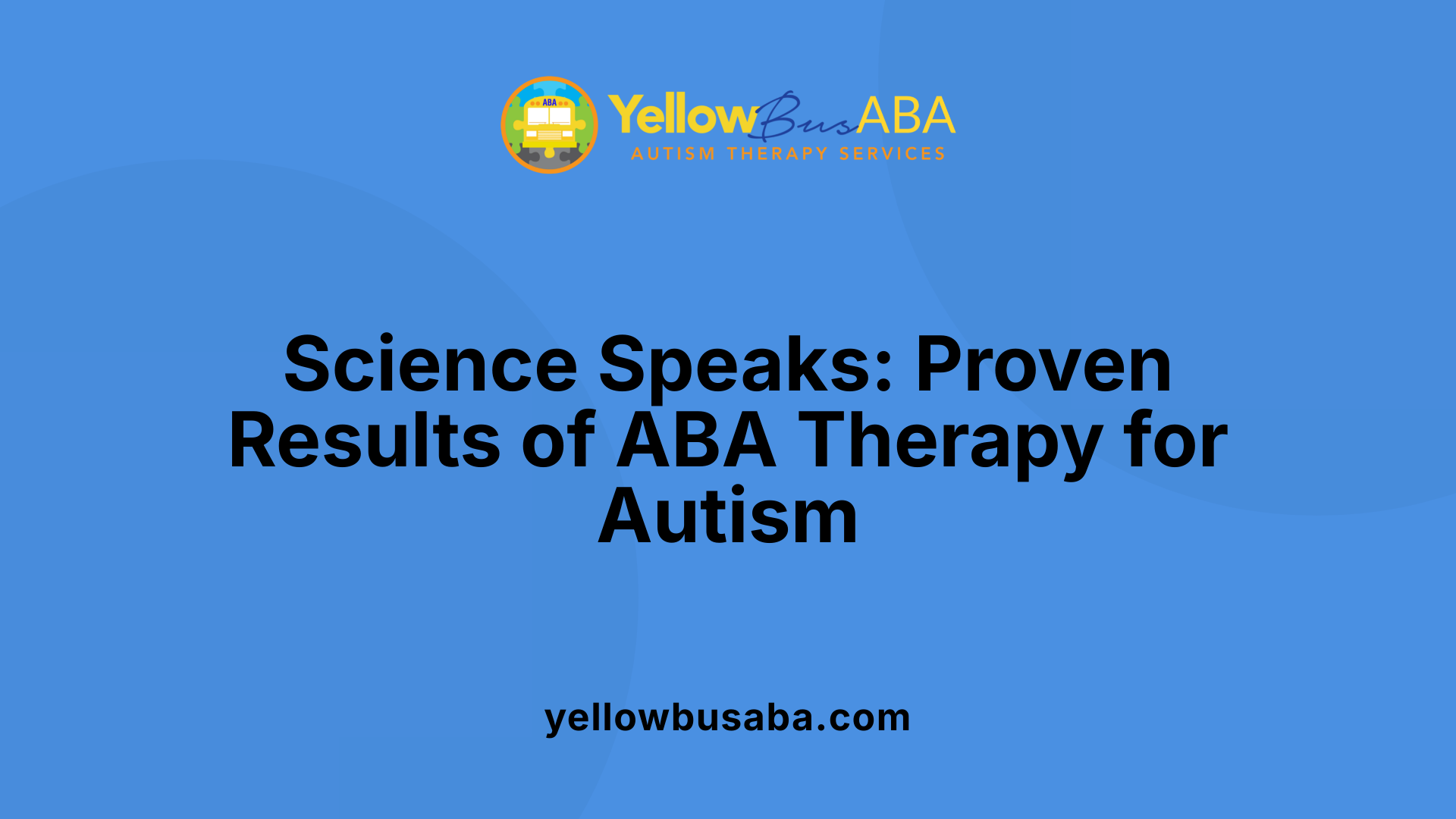The Joy of Watching Kids Discover Their Own Potential
November 18, 2025
Transforming Lives Through Applied Behavior Analysis: A Journey of Growth and Potential

Unlocking Potential: The Transformative Power of ABA Therapy
ABA therapy has become a beacon of hope for families with children on the autism spectrum. Rooted in science and compassion, this approach empowers children to develop essential life skills, fostering independence and joy. This article explores the multifaceted journey of ABA therapy, revealing how it helps children discover and embrace their unique potentials.
Understanding Applied Behavior Analysis: Science Meets Compassion

What is Applied Behavior Analysis (ABA) therapy, and how is it used to support individuals with autism?
Applied Behavior Analysis (ABA) therapy is a scientifically grounded approach that applies behaviorism principles to help individuals with autism develop vital skills. ABA focuses on observable actions and their environmental triggers, aiming to enhance communication, social interaction, academic performance, and daily living skills while reducing challenging behaviors.
Foundational principles of behaviorism and learning theory
ABA is based on learning theory and operant conditioning, originally developed from B.F. Skinner's work. It explores how behaviors are influenced by antecedents (what happens before), behaviors themselves, and consequences (what follows), known as ABC analysis. Through this understanding, therapists can design interventions that reward positive behaviors, making them more likely to be repeated.
ABC analysis and operant conditioning
ABC analysis lies at the heart of ABA, involving careful observation of:
- Antecedents: Events or environments triggering a behavior
- Behaviors: The specific actions or responses
- Consequences: Outcomes that reinforce or discourage a behavior This process helps identify the reasons behind behaviors to promote beneficial changes using techniques like positive reinforcement.
Customization of programs based on individualized assessments
ABA therapy is highly individualized, starting with thorough assessments to understand each child's strengths and needs. Treatment plans are tailored to target skills that foster independence and daily success. Qualified professionals, typically Board Certified Behavior Analysts (BCBAs), oversee ongoing data collection and adapt programs to the individual's progress, ensuring effectiveness across different settings such as home, school, or community.
ABA's evidence-based methods have shown success in improving communication, social skills, and reducing problem behaviors in children with autism, particularly when started early. Family involvement plays a critical role, empowering caregivers to reinforce learned skills consistently.
How ABA Therapy Tangibly Enhances Communication and Social Skills

Communication Improvements Through ABA
ABA therapy is designed to foster meaningful communication gains in children with autism. By focusing on observable behaviors and their triggers, therapists assess communication deficits and tailor individualized treatment plans. These plans promote both receptive (understanding) and expressive (speaking) language skills, supported by data collection and ongoing modifications that reflect the child's progress.
Social Skill Development Techniques
To enhance social interactions, ABA employs techniques such as prompting, video modeling, and naturalistic teaching. These help children learn to engage with peers, understand social cues, and participate in group activities. Reinforcement strategies encourage positive social behaviors, while functional behavior analysis identifies and addresses challenging behaviors that may impede social development.
Role of Positive Reinforcement and Prompting in Social Contexts
Positive reinforcement—a core ABA principle—increases the likelihood of desired behaviors by rewarding them immediately. For social skills, this means that when a child successfully uses appropriate greetings, shares toys, or maintains eye contact, they receive positive feedback that motivates repetition. Prompting offers supportive cues that gradually fade as the child gains independence.
Generalization of Skills Across Settings
ABA therapy emphasizes that skills should be transferable beyond therapy sessions. Families and caregivers are actively involved to reinforce learned communication and social skills at home and in community settings. This broad application helps children apply skills flexibly in different environments and with various people.
Overall, ABA therapy leads to gains in communication and social competence, supporting independence and better integration in everyday life. The evidence confirms its effectiveness in producing these outcomes when programs are customized, carefully monitored, and include family participation.
Behavioral Interventions: Reducing Challenges and Promoting Positive Conduct

How is functional behavior analysis used in ABA therapy?
Functional behavior analysis (FBA) is a fundamental technique in ABA therapy focused on understanding the reasons behind challenging behaviors. By examining the antecedents (what happens before), behaviors themselves, and consequences (what happens after), therapists identify the functions these behaviors serve for the child. This understanding allows for designing specific interventions that address the root causes rather than just the symptoms, ensuring more effective behavior modification.
How does ABA use reinforcement to reduce challenging behaviors?
ABA therapy emphasizes positive reinforcement to encourage desired behaviors. When a child exhibits a target behavior, therapists immediately provide a reward or positive consequence, increasing the likelihood the behavior will occur again. This approach not only reduces problematic behaviors by replacing them with constructive alternatives but also supports skill acquisition in communication, social interaction, and self-care.
What impact does ABA have on problem behavior?
Research reveals that ABA interventions lead to significant reductions in problem behaviors among children with autism. Studies report improvements in approximately 63% to 88% of cases, particularly when ABA programs are tailored to individual needs and delivered intensively. By combining reinforcement strategies with functional behavior analysis, ABA effectively decreases behaviors that interfere with learning and social integration.
How are behavioral interventions tailored to individual needs in ABA?
Each ABA program begins with a thorough assessment conducted by a qualified behavior analyst (BCBA), identifying the child's unique strengths and challenges. Customized treatment plans focus on developing independence and adaptive skills such as communication, academic performance, and daily living activities. Ongoing data collection and progress monitoring allow therapists to modify intervention strategies dynamically, ensuring they remain aligned with the child's evolving needs.
What are the common benefits and outcomes of using ABA therapy for autism?
ABA therapy offers numerous benefits for individuals with autism, including significant improvements in communication skills, social interactions, and everyday functioning. It helps reduce problematic behaviors and enhances adaptive skills such as self-care, play, and academic tasks. The therapy is evidence-based, often tailored to the individual's needs through detailed assessments, and can lead to better cognitive, language, and social development, especially when initiated early and delivered intensively. Techniques like positive reinforcement and naturalistic teaching promote meaningful learning and generalization of skills across settings. Overall, ABA can foster greater independence, social integration, and quality of life for individuals with autism.
The Role of Family: A Crucial Partnership for Progress
Family involvement in therapy
Family participation is a foundational aspect of ABA therapy for children with autism. Parents and caregivers actively collaborate with therapists to reinforce targeted skills at home and in daily routines. This partnership helps create consistency between clinical sessions and natural environments, facilitating the generalization of learned behaviors.
Training parents and caregivers
ABA providers, often Board Certified Behavior Analysts (BCBAs), offer training and coaching for families to equip them with effective behavioral techniques. This empowerment enables caregivers to implement positive reinforcement strategies and behavior plans within the home, increasing the child's opportunities to practice new skills.
Reinforcing skills at home
Skills acquired during therapy sessions are most impactful when practiced regularly in various settings. Families are responsible for reinforcing communication, social interaction, and daily living skills in real-life contexts, thus accelerating progress and fostering independence.
Long-term benefits of family participation
Active family engagement not only boosts immediate therapy outcomes but also sustains gains over time. Studies indicate that children benefit most when caregivers continue to support and model appropriate behaviors, leading to improved adaptive functioning and quality of life.
Who typically provides ABA therapy for individuals with autism?
ABA therapy is delivered by a team of specialized professionals, including licensed psychologists, behavior analysts, and mental health experts, many of whom hold BCBA certifications. These professionals design individualized programs and supervise implementation, while involving families extensively to ensure skills are reinforced beyond therapy sessions. Treatment formats may include in-person, telehealth, and parent coaching models tailored to the child's developmental needs.
The Expertise Behind ABA: Professionals Guiding the Journey
Who Typically Provides ABA Therapy for Individuals with Autism?
ABA therapy is delivered by a multidisciplinary team of highly trained professionals. The core providers include licensed psychologists, Board Certified Behavior Analysts (BCBAs), and mental health specialists skilled in autism-specific interventions. These experts combine knowledge in behavioral science with practical application to deliver individualized treatment.
Training and Certifications
Providers hold certifications such as the BCBA credential, which ensures mastery in designing, implementing, and supervising ABA programs. Many have specialized training in naturalistic teaching methods and learning theory, reflecting the principles of behaviorism central to ABA. Continuous education is common to keep pace with evolving evidence-based practices.
Treatment Delivery Methods
ABA therapy is adaptable, delivered through individual or group sessions, both in-person and via telehealth platforms. Treatment can occur in various environments—home, school, or community settings—to promote skill generalization. Parent coaching is integral, enabling families to reinforce skills consistently across environments.
Supervision and Quality Control
A qualified BCBA typically oversees treatment plans and progress, using data collection and ongoing assessment to modify interventions. This structured oversight guarantees programs remain tailored to each person's evolving needs and align with high standards for ethical and effective care.
By blending professional expertise, rigorous training, and adaptive delivery, ABA providers foster meaningful skill development and behavior improvement for individuals with autism.
Individualization: Crafting Therapy That Fits Each Child's World
How is ABA therapy customized for each child?
ABA therapy begins with thorough assessments to understand each child's unique strengths, challenges, and environment. These evaluations capture skill levels across domains like communication, social interaction, and daily living activities.
What role does personalized goal setting play?
After assessment, therapists design individualized treatment plans targeting specific behaviors and skills to promote independence and success. Goals are evidence-based and tailored to what the child needs most, ensuring therapy is meaningful and relevant.
How is therapy adapted to developmental levels and various settings?
ABA programs are flexible. Therapy sessions occur where the child feels most comfortable — whether at home, school, clinic, or virtually. Intervention techniques and activities are adjusted to match the child's age, preferences, and cognitive abilities.
How do professionals monitor and adjust progress?
Data collection is continuous, tracking the child's performance on targeted skills. Therapists analyze this data regularly, making timely modifications to techniques or goals. This dynamic approach helps maintain effectiveness and respond to the child's evolving needs.
Who delivers and oversees ABA therapy?
Qualified behavior analysts (BCBAs) or trained therapists implement the plan and supervise sessions. They ensure fidelity to the treatment model, guiding families and staff while supporting the child's journey toward improved communication, social skills, and behavior.
Additional Support
Organizations like Key Autism Services assist by connecting families with suitable therapists and handling logistics, making individualized therapy more accessible and consistent.
This comprehensive customization ensures ABA therapy is not one-size-fits-all but a responsive, child-centered journey toward growth and independence.
Early Intervention: The Window of Opportunity

What is Applied Behavior Analysis (ABA) therapy, and how is it used to support individuals with autism?
Applied Behavior Analysis (ABA) therapy is a scientifically grounded approach that uses learning theory and behavior principles to help individuals with autism gain vital social, communication, and adaptive skills. Delivered through individualized plans created and overseen by certified behavior analysts (BCBAs), ABA targets behaviors by studying their antecedents and consequences (the A-B-C analysis). Techniques such as positive reinforcement, prompting, and adaptive communication are applied to encourage helpful behaviors and reduce challenges.
Benefits of early, intensive ABA therapy
Starting ABA therapy early, particularly with intensive programs, is crucial for maximizing developmental potential. Early Intensive Behavioral Interventions (EIBI) involve one-to-one, tailored sessions conducted often over multiple hours weekly. This early focus taps into the brain's neuroplasticity at younger ages, promoting faster acquisition of language, social, and cognitive skills. Early intervention greatly increases the chance for improving independence and reducing problematic behaviors.
EIBI and models like UCLA Young Autism Project and ESDM
Prominent comprehensive models such as the UCLA Young Autism Project and the Early Start Denver Model (ESDM) embody the principles of EIBI. These programs address multiple developmental domains—including cognition, language, social functioning, daily living skills, and problem behaviors—through structured, personalized training. They combine naturalistic teaching settings with evidence-based ABA techniques to foster skill generalization across environments.
Long-term developmental gains in cognition, language, and social skills
Numerous studies show that children with autism receiving early intensive ABA therapies demonstrate significant, lasting improvements. Gains often include enhanced cognitive functioning, stronger language abilities, increased social engagement, and reduced behavioral challenges. While long-term follow-up data is limited, existing evidence supports the positive impact of early ABA on overall development and quality of life.
ABA therapy’s early application creates a critical window where targeted learning and behavior changes yield profound, meaningful progress for children with autism. This established foundation builds lifelong skills and fosters greater independence throughout their development.
Evidence and Outcomes: Scientific Support for ABA Effectiveness

What Does Research Show About ABA Therapy's Effectiveness?
Extensive research and clinical evidence back the use of Applied Behavior Analysis (ABA) therapy in improving outcomes for children with autism spectrum disorder (ASD). Studies consistently document significant gains in multiple skill areas, including communication, social interaction, academic performance, and activities of daily living (ADL). For example, a study of 16 children with ASD in Brazil demonstrated notable improvements in skill performance, with many children independently completing tasks in more than half of their attempts, particularly in academics, social skills, and daily living.
How Successful Is ABA in Enhancing Key Skills?
Reported success rates for ABA interventions vary, but improvements appear in about 63% to 88% of studies reviewed. Commonly enhanced domains include language development, social functioning, intellectual abilities, adaptive skills, and reductions in problematic behaviors. Comprehensive ABA programs such as Early Intensive Behavioral Interventions (EIBI) and the Early Start Denver Model (ESDM) have yielded substantial progress across cognition, language, and social skills in young children.
What Are the Limitations and Areas Needing More Study?
While the evidence supports ABA's effectiveness, gaps remain in long-term follow-up data assessing maintenance and generalization of learned skills. Few studies have measured quality of life (QoL) outcomes or conducted high-quality direct comparisons against other interventions. Only about 4% of relevant studies meet strict criteria for robust impact assessment, underscoring the need for larger-scale, prospective research that evaluates holistic outcomes and addresses sustainability.
How Does ABA Compare to Other Interventions?
Comparative studies show mixed results, with some ABA techniques outperforming others in domains such as problem behaviors and autism severity. However, high-quality randomized controlled trials comparing ABA to alternative therapies are scarce. This highlights the importance of future research focusing on direct comparisons to understand ABA's relative effectiveness fully.
Tools of the Trade: Techniques and Technologies in ABA Therapy
What techniques are commonly used in ABA therapy?
ABA therapy employs a variety of techniques to encourage learning and behavior change. Discrete Trial Training (DTT) is a structured method that breaks skills into small, manageable steps for teaching. Prompting, where cues are given to elicit the desired response, supports skill acquisition early on. Positive reinforcement is central, rewarding desired behaviors to increase their occurrence. Other techniques include video modeling, where children watch videos demonstrating target behaviors, and PESC (Prompt, Educate, Scaffold, and Correct), a strategy to guide learning progressively.
How does technology support ABA therapy?
Modern ABA therapy integrates technology to enhance data collection and intervention tracking. For example, the ABA+ intelligence affective® software is utilized to systematically record skill development in various domains such as language, social skills, and activities of daily living. This digital tracking allows therapists to monitor progress accurately and adjust treatment plans as needed, ensuring individualized and responsive care.
In what settings are these techniques applied?
ABA techniques are flexibly applied across both structured and naturalistic settings. Therapists deliver one-to-one instruction in clinical or home environments while also encouraging spontaneous opportunities to practice skills in real-world situations. This combination fosters skill generalization, helping children apply learned behaviors across different people and settings.
Setting the Stage: Flexible and Inclusive Therapeutic Environments
Where Does ABA Therapy Take Place?
ABA therapy is uniquely flexible in its delivery, occurring across diverse environments tailored to each child's needs. This includes familiar settings such as the home, school, and community locations, as well as specialized clinics. Such versatility ensures that learning moments and behavioral support happen naturally throughout a child’s daily life.
How Are Naturalistic Settings Incorporated?
A significant focus of ABA is learning in naturalistic settings, where children apply skills in real-world contexts. This approach complements structured sessions by providing spontaneous and meaningful practice opportunities. Therapists work alongside family members and educators to embed ABA strategies seamlessly into everyday routines.
How Is Therapy Adapted to Individual Preferences and Needs?
Every ABA program is personalized. Qualified behavior analysts assess individual strengths and challenges to tailor interventions that reflect the child's unique preferences and developmental goals. Flexibility in scheduling, therapy duration, and techniques ensures sessions remain engaging and effective for each learner.
Why Is Generalization Across Settings and People Important?
One of ABA's aims is to help children transfer skills learned in one setting to various other environments and interact confidently with different people. This generalization is critical for true independence. Therapy plans intentionally focus on promoting consistent skill use across all aspects of the child's life, reinforcing learning beyond the therapy room.
Navigating Practicalities: Duration, Coverage, and Access to ABA
Therapy Duration and Intensity Variations
ABA therapy duration and intensity are tailored to each individual's unique needs. Some children, especially those receiving early intervention, may undergo several years of therapy. The number of weekly hours can vary widely, often ranging from a few hours up to 20-40 hours per week depending on the severity of symptoms and treatment goals. Early intensive behavioral interventions (EIBI) have shown particular effectiveness when delivered intensively over the first few years of life.
Insurance Coverage Landscape and Limitations
Insurance coverage for ABA therapy has improved significantly in recent years. Many private insurers and Medicaid plans now cover medically necessary ABA services when prescribed by a physician. However, coverage varies by provider and state, and families may encounter limitations such as caps on hours, provider network restrictions, or requirements for prior authorization. It is important to verify benefits early to understand a specific plan's reimbursements.
Access to Qualified Providers
Qualified providers typically include licensed psychologists, Board Certified Behavior Analysts (BCBAs), and specialized mental health professionals trained in autism interventions. These experts design individualized treatment plans and supervise therapy delivery, which may occur in clinics, schools, homes, or community settings. Telehealth options have expanded access, particularly in underserved areas, though availability still varies regionally.
Advice for Families on Evaluating Providers
Families are encouraged to ask providers about staff qualifications, training, and certifications such as BCBA credentials. Inquire about safety protocols, how goals are set, methods for tracking progress, and session logistics including duration and frequency. Ensuring that therapists involve family members for skill reinforcement and generalization is crucial. Seeking providers who follow evidence-based practices and maintain open communication helps maximize therapy outcomes.
Safety and Ethics: Ensuring a Supportive Therapeutic Experience
How safe is ABA therapy when conducted by qualified professionals?
ABA therapy is generally considered safe when performed by trained and certified professionals such as Board Certified Behavior Analysts (BCBAs). These experts design and oversee individualized programs, ensuring interventions are carefully tailored to each child’s needs and progress.
What ethical standards and certifications support ethical practice in ABA?
ABA practitioners adhere to rigorous ethical guidelines, which are enforced by credentialing bodies like the Behavior Analyst Certification Board (BACB). These standards promote respect, dignity, and the well-being of clients, ensuring treatment goals focus on functional skills and independence rather than compliance alone.
How is the child’s response monitored and therapy adapted?
Continuous assessment is integral to ABA therapy. Through regular data collection and analysis, the therapy team monitors the child’s progress closely. This ongoing evaluation allows for dynamic modification of intervention plans to optimize effectiveness and address any emerging challenges promptly.
How does ABA therapy avoid side effects or negative outcomes?
With a foundation in positive reinforcement and functional behavior analysis, ABA minimizes risks of adverse effects. The focus remains on increasing beneficial behaviors and safely reducing challenging ones without punishment. Family involvement and transparent communication further safeguard the child's comfort and well-being throughout treatment.
Measuring Success: Beyond Skill Mastery to Lifelong Growth
Tracking Progress and Data Collection
ABA therapy involves meticulous data collection to monitor a child's development across various skill areas. Using tools like the ABA+ intelligence affective® software, therapists record progress in attention, language, social skills, and daily living activities. This objective tracking allows for ongoing treatment adjustments tailored to each child’s needs, ensuring that improvements are meaningful and measurable.
Focus on Functional Independence and Quality of Life
While initial ABA goals often emphasize skill acquisition and reducing challenging behaviors, success increasingly includes promoting functional independence in real-life settings. Achievements in academic, social, and daily living skills help children gain autonomy. However, measures of quality of life (QoL), such as emotional well-being and family satisfaction, are less frequently assessed but are critical to understanding comprehensive outcomes.
Challenges in Long-Term Follow-Up Research
Although many studies report significant short-term benefits of ABA, there is a lack of long-term follow-up research tracking maintenance and generalization of skills over years. This gap limits understanding of how well skills persist and translate into adult life. Moreover, few studies perform rigorous comparisons between ABA and other interventions using randomized controlled trials, leaving some questions about long-term efficacy.
Incorporating Holistic Outcomes in Future Studies
Future research is urged to broaden outcome measures beyond skill mastery to include holistic factors like QoL, emotional health, and social integration. Incorporating broader indicators will provide a fuller picture of ABA’s impact on lifelong growth and help refine interventions that support children with autism throughout their lifespan.
Celebrating Milestones: The Joy in Every Step Forward
The journey of children discovering their potential through ABA therapy is a testament to the power of science, dedication, and human connection. From personalized goals to the involvement of loving families and expert professionals, every step reflects progress and hope. While challenges remain in expanding long-term knowledge and access, the profound improvements in communication, social skills, and independence highlight the joy that emerges as children grow more capable and confident. ABA therapy’s essence lies not only in behavior modification but also in nurturing growth, celebrating every achievement, and honoring the unique journey of each child.
References
- How ABA Therapy is Transforming the Lives of Children with ...
- Applied behavioral analysis for the skill performance of ...
- Applied Behavior Analysis in Children and Youth with Autism ...
- Applied Behavior Analysis (ABA)
- Applied Behavior Analysis (ABA)
- 6 Benefits of ABA Therapy for Children with Autism
- The effectiveness of applied behavior analysis program ...
- Applied Behavior Analysis (ABA)
- Applied Behavior Analysis (ABA)


%20(1).jpg)



